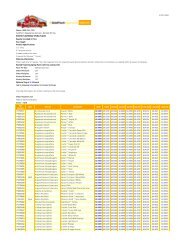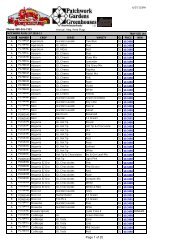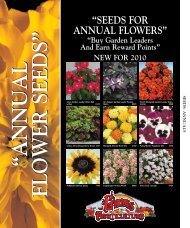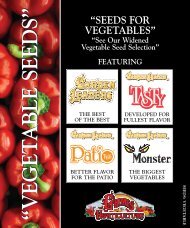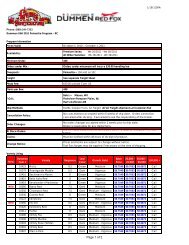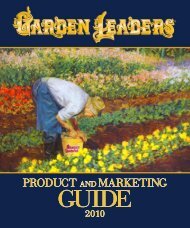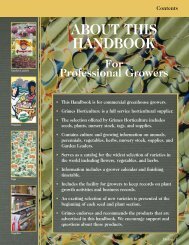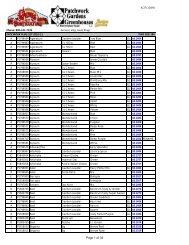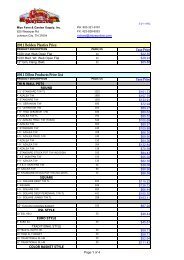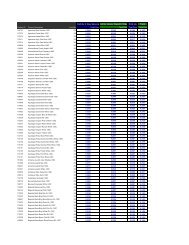TOMATO
TOMATO
TOMATO
Create successful ePaper yourself
Turn your PDF publications into a flip-book with our unique Google optimized e-Paper software.
<strong>TOMATO</strong><br />
(Lycopersicon Lycopersicuni)<br />
Full Sun<br />
Part<br />
Shade<br />
Popularity of the Tomato<br />
A fine source of the vitamins A and C, the common tomato is<br />
easily grown in almost any backyard. Because of its food value,<br />
many uses and ease of culture, the tomato is probably the plant<br />
most widely grown by any gardener.<br />
Growing the Tomato<br />
Planting and gardening in the proper manor is part of the formula<br />
to growing great tomato plants. To grow perfect tomatoes<br />
remember that the tomato plant is only ready and willing to<br />
deliver if you give it the full range of conditions that it requires. Hardiness of each tomato plant will<br />
be determined by the basic requirements outlined below.<br />
Tomato: Planting - The tomato is a warm-season plant which requires a fairly long<br />
growing season. You may live in an area where seed can be planted directly in the garden, but<br />
in most regions they must be started in a hotbed or indoors.<br />
Tomato: Culture - As warm-weather plants tomatoes require an open, sunny, well-drained<br />
location in the garden. Avoid poorly drained spots where rainwater tends to form a pool. Many<br />
diseases of tomatoes are associated with poor drainage.<br />
Tomato: Transplanting - Young tomato plants are set out as early as possible to hurry<br />
their growth, and it is sometimes necessary to protect them against late frost damage. Invert<br />
peach baskets or paper bags over the tomato plants during unusually cold nights.<br />
Tomato: Staking - Perhaps the most desirable method of growing tomatoes is to stake<br />
and prune them. More plants can occupy a given space this way, and the difficulties of<br />
cultivation are greatly decreased.<br />
Tomato: Harvesting/Varieties - During the summer, tomato vines should provide a<br />
steady supply of fresh fruit for family use. Later, when the crop reaches its peak, you will<br />
probably want to preserve much of it for future use. Whichever way you choose, you can plant<br />
varieties of tomatoes bred especially for your purpose.<br />
Tomato: Pests/Diseases - Tomatoes have a built-in insect repellent called solanine that<br />
will repel many insect pests. The tomato hornworm is probably the most serious pest of<br />
tomatoes, although Japanese beetles, cutworms and other pests also bother the plants.
The proper soil for tomatoes:<br />
The most important factor in the growth of tomato plants. Roots breathe the way you do. Deprived<br />
of air, roots, or portions of roots die of suffocation. Make sure soil is loose and friable, permitting<br />
good drainage for your tomato plants.<br />
Watering tomatoes:<br />
Neither too much, nor too little. Too much water can drown tomato plant roots, especially if soil is<br />
heavy. Too little water can stop tomato production.<br />
Nutrient requirements of tomatoes:<br />
The daily requirements of tomato plants for nutrients is small, but that amount should be available<br />
when the plant needs it. Always follow package or bottle directions of the fertilizer that you use for<br />
best results as you grow your tomato plants.<br />
Maintenance of the Tomato Garden<br />
To produce a bumper crop of tomatoes you will need to monitor their progress throughout the<br />
growing cycle. The following points are critical to growing the perfect tomato.<br />
• Sunlight: To a plant, light is life. Sunlight is used by the leaves to convert raw materials<br />
into useable plant food, and provides the energy required for photosynthesis. The tomato<br />
should have 8 hours of continuous sunlight, but can get along with less. However the less<br />
sun that the plants receive the more it will negatively affect their rate of growth and<br />
production.<br />
• Temperature: Most tomatoes need night temperatures between 55° and 75° to set fruit.<br />
But there are varieties that will set fruit at lower and higher temperatures. Read the<br />
planting and growing tips found on your seed pack or plant tray.<br />
• Protection of leaves and roots: Leaves and roots need protection from temperature<br />
extremes, strong winds, birds and beasts, weed competition, and pests and diseases.<br />
But if you've satisfied the first five requirements, the plant is in a good position to protect<br />
itself from any damager, and will require much less protection from the gardener.<br />
Growing the best tomatoes<br />
You don't have to be a horticulturist to grow tomatoes or to put the basic rules of<br />
plant growth together. It seems to us that what trips up many a grower of tomatoes<br />
is a lack of concern with one or another of the needs of the plant. Actually, these<br />
fundamentals are one fundamental; all must act in unison.<br />
You can go into the garden, look at a tomato plant, and decide that it needs more<br />
fertilizer. Fine—but you should bear in mind that fertilizing, the nature of the soil in<br />
which the tomato vine is planted, and your watering habits are all interdependent. If<br />
you plant a six-pack of the tomato variety recommended by your garden store, and<br />
all plants grow and produce well, you can count yourself lucky. But if your<br />
experience hasn't been all that successful, the preceding advice may be helpful.



